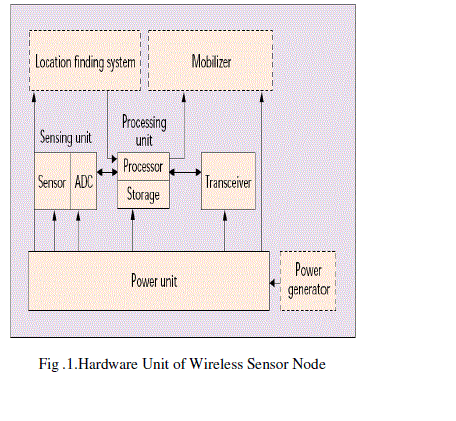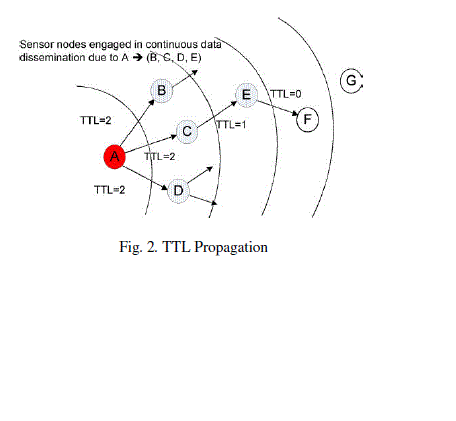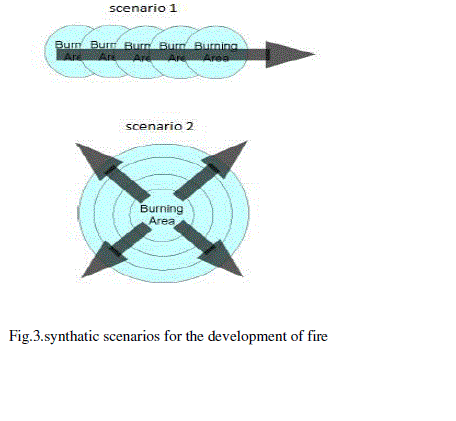Keywords
|
| Critical Event Monitoring, Sleep Scheduling, Wireless Application Protocol, WSN. |
INTRODUCTION
|
| The energy consumption is the major problem in a WSN .The studies regarding with WSN are mainly focused on the energy consumption reduction methods. The basic aim of Wireless Sensor Network is to collect the data for processing and reporting. Based on the data reporting the Wireless Sensor Networks are classified as time driven data reporting scheme, event driven data reporting scheme, and the use of both reporting schemes. In event driven data reporting scheme the sensor node report the sudden variation of sensed value in to the base station. In time driven data reporting scheme, it continuously monitor the Wireless Sensor Network and transmit the data continuously over a time. The energy consumption is determined from the total distance for data transmission and the total communication amount. The event driven data reporting schemes consumes lower energy, but the accuracy level is very poor. In the case of time driven data reporting scheme, it provide high accuracy but the energy consumption is very much high, because it continuously send the sensed value to the base station. If the wireless sensor network uses both the data reporting schemes, higher accuracy can be achieved also the energy consumption reduced by a small amount than the previous method. The dynamic switching between this data reporting schemes is controlled by the use of hybrid data gathering protocol. [2]. |
| In this paper we propose a sleep scheduled hybrid data gathering protocol based on dynamic switching of data reporting schemes. The sleep scheduling is used during the event monitoring process and this reduces the energy consumption so that the wireless sensor network can work for a long time without recharging there batteries. The sleep scheduling can cause some broadcast delay because the source node waits until the sink node are active and ready to receive the message. The level- by-level offset based sleep scheduling is used in this paper .This reduces the broadcast delay as well as the energy consumption. The dynamic switching between the two data reporting schemes help to reduce the energy consumption and also the accuracy level of wireless sensor network can be increased. In this paper we consider a forest fire detection system with sleep scheduled hybrid data gathering protocol. In this, all the wireless sensor nodes are sleep scheduled with a level- by- level offset wake up patterns. The sleep means, most of time the sensor nodes are stay in low power mode and the sensor nodes are periodically wake up to check or monitor the node activities. When the temperature at a particular region is increased, Sensor nodes are wake up when the nodes have just got the data packet. Here the nodes are in event driven data reporting scheme. So it will suddenly inform the base station or an observer, that the Particular event is occurred. Because the sensor nodes are reacting suddenly to the rise in temperature, and it will again go to sleeping mode as early as possible then they retransmit the data packet to the nearest neighbouring nodes . However the sensor node realize that the event is not transient, then they switch to time drive data reporting scheme and continuously give the data to an observer. Otherwise the sensor nodes switch back to event driven data reporting scheme then to the sleep mode. |
| The contribution of this paper have three sections .first, we design a hybrid data gathering protocol which dynamically switch between event driven data reporting schemes and time driven data reporting schemes. Second, level-by-level offset based wake up pattern is introduced with this protocol. Third, we evaluate the system using simulation studies and calculate the energy consumed by each node |
II. RELATED WORKS
|
| The proposed system architecture consists of training phase and detection phase. Here we elaborate each block of the proposed system in detail. Basically the study of existing wireless sensor networks are concentrated on energy consumption reduction methods. In order to reduce the energy consumption, there are different techniques are proposed in the literature for wireless sensor networks. |
| Usually, a wireless sensor networks consist of large number of wireless sensor nodes, which are developed over a particular area. For reducing the communication amount and transmission distance different techniques are employed such as clustering, different node role assignments, sleep scheduling, hybrid data gathering protocol etc |
| In cluster based approach, the nodes are divided into clusters with one node acting as a high energy local base station for each cluster, and there is a single global base station for the entire wireless sensor network. In this method the local base station communicate with global base station. In each cluster, the nodes can communicate directly to the base station. This technique reduces the transmission distance when compared to direct communication .The main challenges faced by the cluster based approach includes how to select the cluster heads, how to organize the local clusters and non uniform energy depletion take place between cluster heads and cluster members[3][4]. Depending upon the dynamic switching between data reporting schemes APTEEN, hybrid data gathering protocol are related to the current work |
| In APTEEN it uses hard and soft threshold values, the sensor nodes are transmit data only when the sensed value is within the threshold range. There will be a count time, it is the time period between two consecutive data report send by the wireless sensor node. But this method consumes more energy. [5]. |
| In hybrid data gathering protocol, there will be two data reporting schemes such as time driven and event driven. The dynamic switching between these reporting schemes is controlled by hybrid data gathering protocol. When an event occurs, the sensor node report the base station that the particular event is occurred, at that time the node is in event driven data reporting schemes, if the event is not transient, then it will switch to time driven data reporting schemes, so the nodes continuously disseminate the measured value to an observer By using this method, the spreading pattern of an event is predicted. But it consumes more energy. In order to overcome the above mentioned disadvantages the proposed system can be used. |
III. PROPOSED SYSTEM
|
| It is known that the alarm could be originated by any node which detects a critical event in the wireless sensor network. The proposed method includes, every node is sleep scheduled with a level by level offset based wake up patterns. |
| ïÃâ÷ When an event occurs, it switches dynamically between time driven and event driven data reporting schemes. |
| ïÃâ÷ It will determine the nodes which are also close to the event occurring node. |
| In ideal condition the sensor nodes are in sleep, which means the processing part of a sensor node is active whenever a node receives data packet. And the communication part of the wireless sensor node is always active, so the received data can be further broadcast at any time. When the temperature of a particular node is greater than 100Ãâ¹ÃÅ¡C, then the nodes suddenly respond against this change, at this time the nodes are wake up. And they are in event driven data reporting scheme. So an alarm is send to the base station and informs the base station that the particular event is occurred. However once the sensor node found that the event is not transient then the nodes are switch to the time driven data reporting scheme. In this, the nodes are periodically sending the measured temperature value to the base station and also note that at this stage, nodes are in sleep mode. When the temperature is goes below 100Ãâ¹ÃÅ¡C, then the nodes are switch back to event driven data reporting scheme. The dynamic switching is controlled by a hybrid data gathering protocol. This paper is based on three algorithms such as |
| ïÃâ÷ Level-by –Level offset based Sleep Scheduling Algorithm. |
| ïÃâ÷ Parameter based event detection algorithm (PED). |
| ïÃâ÷ Parameter based event detection algorithm (PED). |
A. Level –By-Level Offset Based Sleep Scheduling Algorithm
|
| Sleep scheduling is energy efficient mechanism that increases the life time of the wireless sensor network. In this paper level by level offset based wake up pattern is used. This means that the nodes are wake up when it have just gotten a data packet. And go to sleep mode as soon as possible. In sleep mode the nodes are capable for transmit data packet to their neighbouring nodes. Any node which detects a critical event sends a data packet to the base station according to level by level offset pattern. So the base station knows that the particular event is occurred. After that the base station broadcast the data packet to the neighbouring nodes according to level by level offset wake up pattern. |
| After that, the neighbouring nodes as well as the event occurred nodes periodically send the measured temperature value to the base station according to the level by level offset based wake up pattern[5][6]. |
B.PARAMETER BASED EVENT DETECTION ALGORITHM(PED)
|
| In PED algorithm, there will be a threshold value. Whenever the sensed value is above the threshold value, then the event occurred sensor node immediately report the base station or an observer, that the particular event is occurred at wireless sensor network and send the sensed value to the base station. The PED algorithm works as follows, in ideal case all the sensor nodes are in event driven data reporting scheme as well as in sleep mode. When the sensed value is above the threshold value, then we can understand that the critical event is occurred. At this time the sensor node wake up and immediately switch back to sleep mode. In this stage the critical event occurring node sends a data packet into the base station. The base station is connected to a processor. From this processor the observer can monitor the environment changes. If the critical event is not transient, then the nodes switch to time driven data reporting scheme, the nodes periodically send the sensed value to the base station. |
C.PARAMETER BASED AREA DETECTION ALGORITHM(PAD)
|
| By using the PAD algorithm, the range of neighbourhood can be detected. This algorithm is mainly based on two parameters, such as time to live (TTL), valid time (VT) [2].The TTL indicate the number of jumps within which sensor node must switch to time driven data reporting scheme. Or it specifies the number of hops that, the information can travel before it should be discarded. Note that the TTL value should be greater than zero. When the node receives the broadcast information containing a TTL value, then it switches to the time driven data reporting scheme, then it will rebroadcast the decremented by one TTL value. The current temperature value measured by the sensor node which is very close to the forest fire is able to trigger an event than those nodes which is situated away from fire, so the closely located node detect an event in the near future is high. The second parameter is valid time VT, when the sensor node realizes that the abnormal phenomenon is not transient, then the node will switches to time driven data reporting scheme, so the sensor nodes can continuously monitor the temperature variations and gives the sensed value to the neighbouring nodes. The valid time specifies how long the sensor node should remain in the time driven data reporting scheme. Therefore without valid time they could suddenly switch back to event driven data reporting scheme, so this will lead a chance of losing the important information in advance |
IV. SIMULATION RESULT
|
| In order to evaluate our approach we use java software. The Wireless sensor network is simulated using a network simulation tool NS2.The simulation was performed by using a 24 wireless sensor node. The nodes are placed randomly on a network and the nodes are in stationary state. We simulated 2 synthetic experimental fire scenarios which are shown in figure 3.In scenario1, the fire moves horizontally overtime. In scenario2 the fire expands in all the directions. Throughout the work the sensor node measures the temperature in every sec. and the node start to react when it goes above 100Ãâ¹ÃÅ¡C.in this work, the TTL value is set as 3 sec. and VT set as 1 sec. The wireless sensor nodes are sleep scheduled with three level by level based wakes up pattern. The duty cycle is set as 1 sec. Real time analysis of wireless sensor network is presented in this paper. The use of java software made the work easy because of the simplicity in design and easy use of toolbox |
A. Performance Comparison
|
| We conducted the simulation study by analyzing the performance of a sleep scheduled hybrid data gathering protocol against hybrid data gathering protocol. In the case of hybrid data gathering protocol, the behavior is explained as follows, when the temperature at the particular area is above 100Ãâ¹ÃÅ¡C.Then the nodes switch from event driven to time driven data reporting scheme according to PED. |
| The range of neighborhood is predicted by using PAD algorithm. In sleep scheduled hybrid data gathering protocol level by level offset based wake up pattern is used with PED and PAD in this, the nodes are in sleep and it wakes up, when it receives a data packet. In this paper we consider node 15 as the event occurring node. And also analyses the energy consumed by each node. From table 1, it is clear that the energy consumed by the level by level offset based sleep scheduling is much lower than the use of ordinary hybrid data gathering protocol. |
V. CONCLUSION
|
| In this paper we have introduced a hybrid data gathering protocol with level-by-level offset based wake up pattern. This method combines the best features of both proactive and reactive networks. This method provides periodic data collection as well as the spreading pattern monitoring with lower consumption of energy. Theoretical analysis and the conducted simulation studies showed that, the energy consumption of the proposed scheme is much lower than that of existing methods |
Tables at a glance
|
 |
| Table 1 |
|
| |
Figures at a glance
|
 |
 |
 |
| Figure 1 |
Figure 2 |
Figure 3 |
|
| |
References
|
- S. Bilouhan and R. Gupta, “Optimization of Power Consumption in Wireless Sensor Networks,”International journal of scientific &Engineering Research,vol.2,no.5,may 2011,pp.1-5
- Byoung-Dai Lee and Kwang-Ho Lim, “An Energy Efficient Hybrid Data Gathering Protocol Based on Dynamic Switching of Reporting Schemes in a Wireless sensor Networks,”IEEE Systems Journal ,vol.2,no.3,September 2012.
- S. Lindsey and C. Raghavendra, “PEGASIS: Power-efficient gathering in sensor information systems,”in Proc. IEEE Aerospace Conf., Mar.2002, pp. 1125–1130
- Manjeshwar and D. Agarwal, “ATEEN: A hybrid protocol for efficient routing and comprehensive information retrieval in wireless sensor networks,”in Proc. Int. Symp. Parallel Distrib. Process. 2002, pp. 195–202.
- Peng Guo, Tao Jiang, Senior Member, Qian Zhang, Fellow IEEE,andKui Zhang, “Sleep Scheduling for Critical Event Monitoring in Wireless Sensor Networks,”in IEEE Transactions on Parallel and Distributed Systems,vol.23,no.2,february 2012,pp.345-352.
- Arul Xavier V. M, Angelin Jeyaseeli D, “Delay Efficient Approaches for Sleep Scheduling in Wireless Sensor Networks,”in international journal of scientific & technology Research vol.2,Issue1,January2013,ISSN 2277-8616.
|